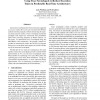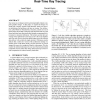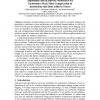73 search results - page 1 / 15 » Using Trace Scratchpads to Reduce Execution Times in Predict... |
120
click to vote
RTAS
2008
IEEE
15 years 7 months ago
2008
IEEE
Instruction scratchpads have been previously suggested as a way to reduce the worst case execution time (WCET) of hard real-time programs without introducing the analysis issues p...
126
click to vote
RTAS
2010
IEEE
14 years 11 months ago
2010
IEEE
—Hardware-managed caches introduce large amounts of timing variability, complicating real-time system design. One alternative is a memory system with scratchpad memories which im...
111
Voted
SASP
2008
IEEE
15 years 7 months ago
2008
IEEE
Ray tracing is a technique used for generating highly realistic computer graphics images. In this paper, we explore the design of a simple but extremely parallel, multi-threaded, ...
109
click to vote
DCC
2007
IEEE
16 years 7 days ago
2007
IEEE
Instruction and data address traces are widely used by computer designers for quantitative evaluations of new architectures and workload characterization, as well as by software de...
111
Voted
IPPS
2007
IEEE
15 years 7 months ago
2007
IEEE
As real-time systems become more prevalent, there is a need to guarantee that these increasingly complex systems perform as designed. One technique involves a static analysis to p...



